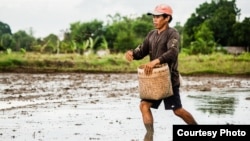LOS BAÑOS, PHILIPPINES —
Crop scientists from around the world are in the Philippines this week at the International Rice Research Institute, exchanging ideas on how flooded rice and other staple crops could stay alive for long periods.
Scientists at the International Rice Research Institute have already found a way for several varieties of rice to live after being totally submerged for more than 10 days: certain kinds of rice can be crossbred with a gene called SUB1, which stops the rice from growing while it is underwater, thus preserving itself. About five years ago, farmers in the Philippines, Indonesia and several South Asian countries started growing these varieties.
Despite that success, IRRI Principal Scientist Abdelbagi Ismail says close to 25 million hectares of rice is lost to flooding every year in Asia and Africa alone. There are about 150 million hectares of rice worldwide.
With one seventh of the total crop lost, Ismail says researchers want to find a way to make flooded rice survive even longer, so they are now looking more closely at the work of researchers who study how plants survive without oxygen.
“Now SUB1 can protect up to two weeks, but sometimes we get floods up to 25 days. So we lose it even with SUB1. So we want to see if we can increase flooding tolerance by more than one week- additional to SUB1. Any information that comes from these studies could help us,” explained Ismail.
Ismail also pointed out that IRRI, whose work is heavily focused on how rice adapts to flooding, is currently concentrating on three areas. Scientists want to help inundated rice sprouts continue to grow normally, discover other genes that can perform the same function as SUB1, and breed varieties that can withstand total and partial submersion. This last goal will be particularly helpful for many rice-growing areas, as during the rainy season flooded soil will oftentimes never completely drain.
Researchers are still working to understand how plants are able to sense low oxygen levels, which sends them into survival mode.
Scientist Laurentius Voesenek, of the Netherlands’ Utrecht University, researches wild plants that live in partial submersion or flood-prone river areas, focusing on fundamental traits that help plants cope with flooding. Voesenek’s work is on ethylene, a gas emitted by plants once they become submerged.
“Gases produced by the plant can only very slowly escape. So if production continues it builds up and that is a very reliable signal for the plant to know ‘I’m under water. I’m in trouble. I have to do something. Switch on genes which might protect,’” explains Voesenek.
Scientists are also sharing work on crops that can be grown despite stagnant flooding. Ismail says this work is important, and will help discover how farmers can use the wet soil of flooded rice fields for other staples such as maize, wheat and barley.
Scientists at the International Rice Research Institute have already found a way for several varieties of rice to live after being totally submerged for more than 10 days: certain kinds of rice can be crossbred with a gene called SUB1, which stops the rice from growing while it is underwater, thus preserving itself. About five years ago, farmers in the Philippines, Indonesia and several South Asian countries started growing these varieties.
Despite that success, IRRI Principal Scientist Abdelbagi Ismail says close to 25 million hectares of rice is lost to flooding every year in Asia and Africa alone. There are about 150 million hectares of rice worldwide.
With one seventh of the total crop lost, Ismail says researchers want to find a way to make flooded rice survive even longer, so they are now looking more closely at the work of researchers who study how plants survive without oxygen.
“Now SUB1 can protect up to two weeks, but sometimes we get floods up to 25 days. So we lose it even with SUB1. So we want to see if we can increase flooding tolerance by more than one week- additional to SUB1. Any information that comes from these studies could help us,” explained Ismail.
Ismail also pointed out that IRRI, whose work is heavily focused on how rice adapts to flooding, is currently concentrating on three areas. Scientists want to help inundated rice sprouts continue to grow normally, discover other genes that can perform the same function as SUB1, and breed varieties that can withstand total and partial submersion. This last goal will be particularly helpful for many rice-growing areas, as during the rainy season flooded soil will oftentimes never completely drain.
Researchers are still working to understand how plants are able to sense low oxygen levels, which sends them into survival mode.
Scientist Laurentius Voesenek, of the Netherlands’ Utrecht University, researches wild plants that live in partial submersion or flood-prone river areas, focusing on fundamental traits that help plants cope with flooding. Voesenek’s work is on ethylene, a gas emitted by plants once they become submerged.
“Gases produced by the plant can only very slowly escape. So if production continues it builds up and that is a very reliable signal for the plant to know ‘I’m under water. I’m in trouble. I have to do something. Switch on genes which might protect,’” explains Voesenek.
Scientists are also sharing work on crops that can be grown despite stagnant flooding. Ismail says this work is important, and will help discover how farmers can use the wet soil of flooded rice fields for other staples such as maize, wheat and barley.









